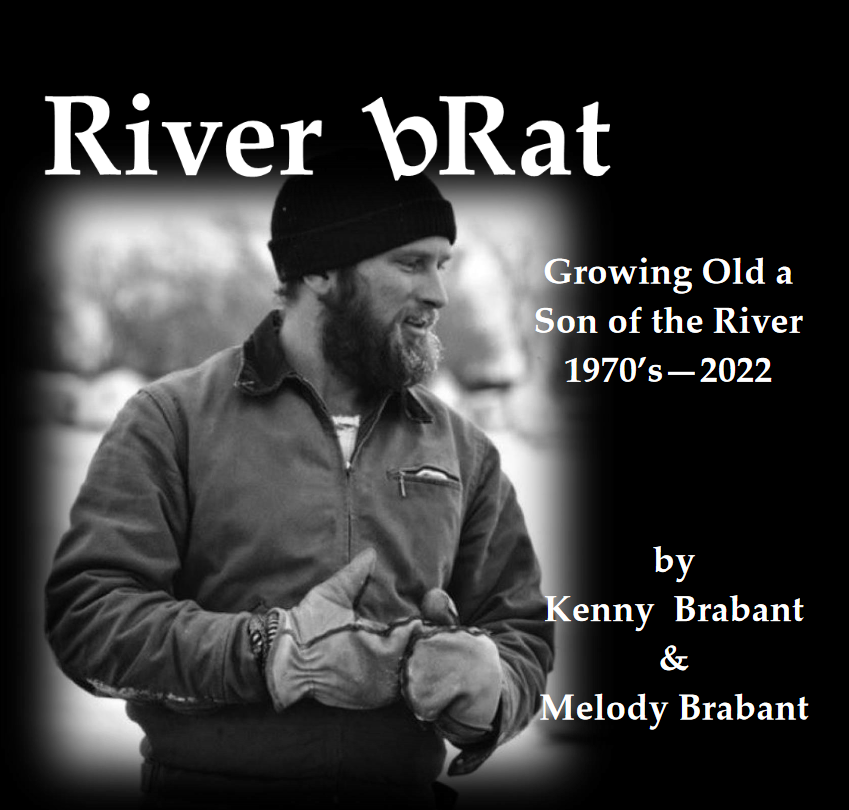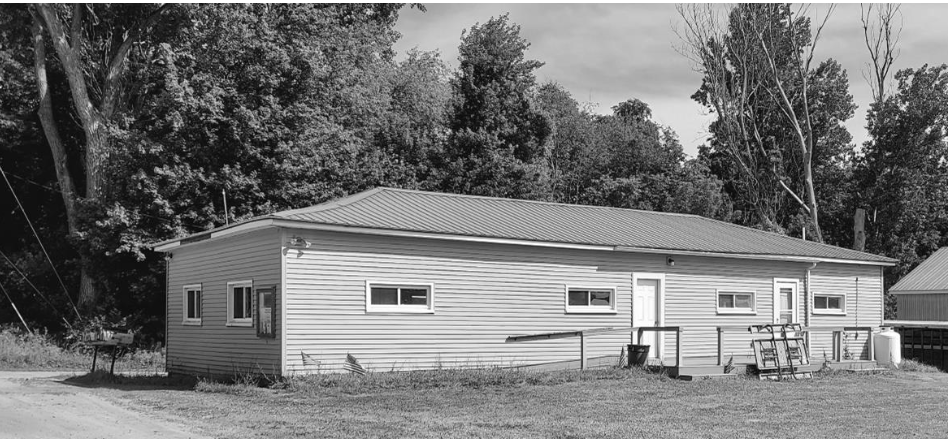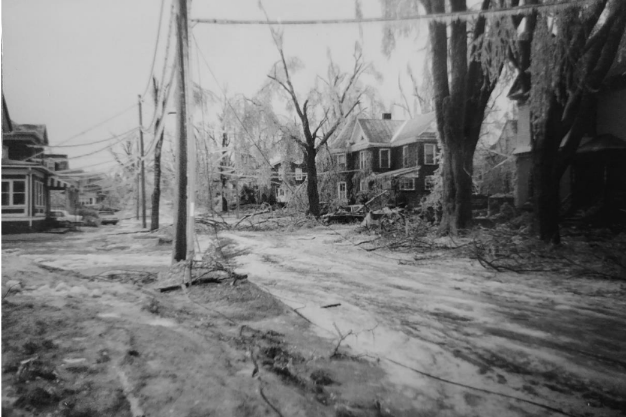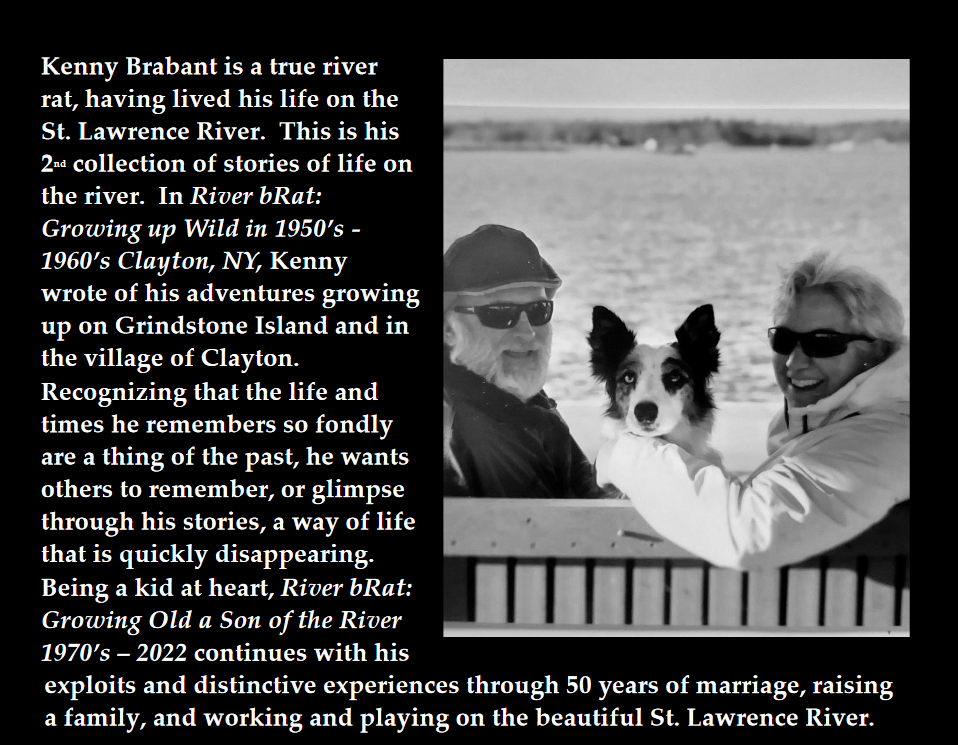I am starting this book review with a note I sent to Melody and Ken Brabant about their book:
“Few capture the true feelings of the River or Family like you two and your Mum, Nancy Bond, who is no longer with us. Others who were successful were Rex Ennis, Robert Matthews, and Hunter Grimes. All are gone, and all are owed a debt of gratitude for capturing our River and its stories. The best part is you two are still going strong. So thank you for sharing River bRat Growing Old with me and for everything else you do in the community.”

Yes, Melody and Ken Brabant have written their Book Two to complement their River bRat. At the time, I was given a copy and wrote my Book Review in August, 2021. Yes, highly recommended.
River bRat Growing Old, Son of the River 1970's-2022, is different as I actually recall those dates and times, and I recognize many of the “River people” and I have visited the “places”. However, even if you do not know Grindstone Island or Clayton, NY, the book carries family experiences often duplicated in the North Country or in Eastern Ontario. I have permission to share two excerpts to demonstrate what I mean.
It is indeed a book I did not want to put down, especially when I got to the final chapter, the first paragraph prepared me for the sensitive and touching words that followed: “On April 11th, 2010, our 33-year-old son, Keith, was senselessly shot and killed.”
Perhaps readers, you too will remember that time and the sadness expressed. Still, the Brabant family and friends turned the tragedy into a legacy that lives on with the establishment of the Keith Brabant Music Scholarship. The Brabants work tirelessly on the annual KeithFest music festivals to develop and build a program that will live on – just as the memory of a son lives on.
Ken writes that
So, I understand that some of my stories may seem far-fetched or at least exaggerated, but I assure you they are told just as I remember them, with no embellishment. These years were worthy of wearing a “Life is Good” tee shirt every day!
This Editor, and TI life readers thank you, Ken and Melody, for your memories, your words and most of all, your willingness to share. It is appreciated.
Excerpts

Dodge Hall and Dances
The Dodge Hall on Grindstone was donated to the community by my great uncle, Emmet Dodge, who had lived and worked there during his life. It is where many island dances, meetings, and events have been held for generations. The earlier residents of Grindstone were mostly farmers, who held dances and card parties regularly at their homes; it was a way to socialize and break up the work week. After the Dodge Hall was built, the parties moved there.
Many of the residents were musicians and would bring their instruments along, and the gatherings just evolved into a regular Saturday night dance. When I was young, it was primarily still square dancing, with the island families playing and calling the squares. Charlie Matthews did most of the calling while smoking his home-rolled cigarettes. Between that and his gruff voice, you pretty much needed to know the calls, because you couldn’t make out what he was saying - but he made those dances what they were and was missed when he stopped calling.
During my young adult years, the dances changed. Farming was dying out, and the older generation was too. Country and rock bands started coming over from the mainland to play the dances, and boatloads of mainlanders with them. And as the farmland was sold off to cottagers, the island population grew, and its
makeup changed.
Living back on the island with my family, we were again attending these weekly dances. There were differences from when I was a teen, but my boys were entering their teen years, and it was the same in many ways too. We’d usually have a vehicle full of kids, our boys and their friends, nieces and nephews. Often it would be a caravan of vehicles leaving the farm, with other families who had come over for the dance.
On arriving at Dodge Hall, people would scatter, the little ones running all around in and out of the hall, the teens off to the beach, returning later in the evening or hanging outside, sneaking beers when they could. The adults were catching up with friends, and what everyone had been up to all week. Everyone danced, toddlers to seniors, and having all these generations together, relatively peacefully, was special. The older people, and mothers with babies would go into the kitchen area, where it was quieter; and there were couches and cribs for the little ones to sleep while parents danced and visited.
At the peak of summer, on the hottest nights, we’d head to the beach afterwards for a swim or to play flashlight tag with the kids - throwing the flashlight into the water and seeing who could swim to it first. The water always seemed warmer at night, and the sky spectacular.
On the trip home, everyone in high spirits, the kids would cheer me on, to “jump” airplane hill. We’d get the sleeping little ones settled into bed, then the rest would have something to eat while sitting around the table sharing highlights of the evening; then off to bed, where everyone slept soundly. These seemingly once-in-a-lifetime evenings were ours all summer long, and we enjoyed them.
Storms

While I suspect it won’t compare to what lies ahead, here is what I remember of some past storms and extreme events. During the blizzard of 1977 I worked at Frink’s Snowplow. Everyone was snowed in for days, but living three blocks away, I was able to get to work by snowmobile. I remember seeing the plow at work on Bartlett Point, and it would back up and ram into a snow drift over ten feet tall repeatedly, getting only one or two feet forward with each effort (working at Frink’s I heard tales of this type of hard service snapping trucks in two between the cab and the bed). Town employees had to drive loaders across the frozen river to Grindstone Island to clear their roads too (the plow truck over there wouldn’t do it). I can only imagine how crews unfamiliar with, and leery of winter ice felt driving across it.
The first time we ever heard of a “microburst” (a fast-moving storm with strong, straight-lined winds) was in 1995 when we were in the path of one. We were living at a farmhouse on Grindstone, and it brought a giant oak tree down parallel to and barely missing the house. Many in the area were not as lucky. It was estimated that more than 500 structures - homes, barns, businesses, were severely damaged or destroyed. Most of the summer residents just headed home after that, knowing it would be weeks if not months before their summer homes were repaired or electricity restored.
We experienced another summer storm while at Mid-River Farm. The most striking (pun intended) thing about this one was the nearly constant lightning strikes; bolt after bolt flashing all around us. It felt (I imagine) like being in a war zone. I was at work next door and received a good jolt through an electrical outlet. When I got home, I discovered the well/pump controls and the telephone lines had been burnt out. Memorably, the clothes that had been hanging on our metal clothesline were now full of burn holes from a direct lightning strike.
In 1998 we were hit with a major ice storm. I was with a bunch of other guys that night at my friend Tim’s for our weekly “garage meeting.” People were coming
in and out, saying “Boy, it’s getting bad out there.” We could hear the tree
branches starting to crack under the weight of ice, but really didn’t think
too much of it - just another storm. But when we all finally went outside, everything was coated in several inches of ice and branches were down all over the place. The freezing rain kept up for four days, and the recovery took weeks. Trees were fricasseed, the power poles downtown had toppled like dominoes; and we were without power for days, weeks for some.
Grindstone Island was down for 27 days, I remember. The reason I remember is I had cows over there that winter that needed to be fed and watered. They couldn’t make it down the ice-covered hill to drink from the river as they had been doing. I got to the island by boat, going around the head of the island to Mid-River, then had to clear the road of trees to get to the farm, and then further down the road. It was a big deal on the national news, but we were without power or phones, so never did hear any of the reporting until well after the fact - but we lived it!
The Army dropped off huge generators at many farms so farmers could milk their cows, but without the operators needed to connect or get them running. My friend Kyle is an electrician and I had worked with this equipment during military service, so knew how to operate it. After the equipment was dropped off, we went around and got it running. What I remember most from arriving at these farm visits was the cows mooing constantly, in extreme discomfort from needing to be milked.
_____________
Highly recommended!

This Editor, and TI life readers, thank you, Ken and Melody, for your memories, your words, and most of all, your willingness to share. It is appreciated.
The book is available at Reinman's Dept store and The Little Book Store in Clayton, NY, or directly from the Brabants. And, please let us know if the River bRat stories are similar to your youth!
By Susan W. Smith, Editor, info@thousandislandslife.com
Posted in: Volume 18, Issue 9, September 2023, Book review
Please click here if you are unable to post your comment.
